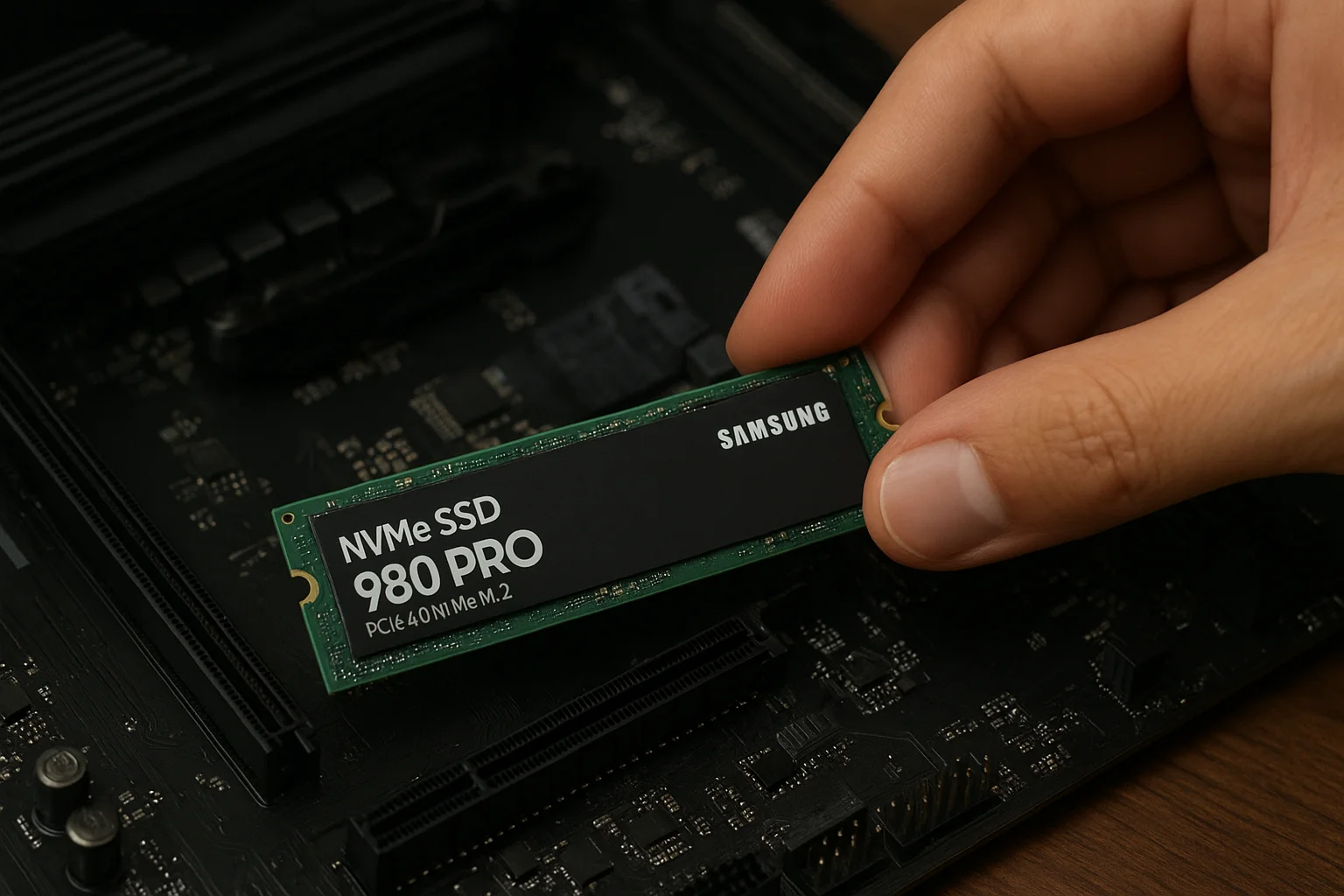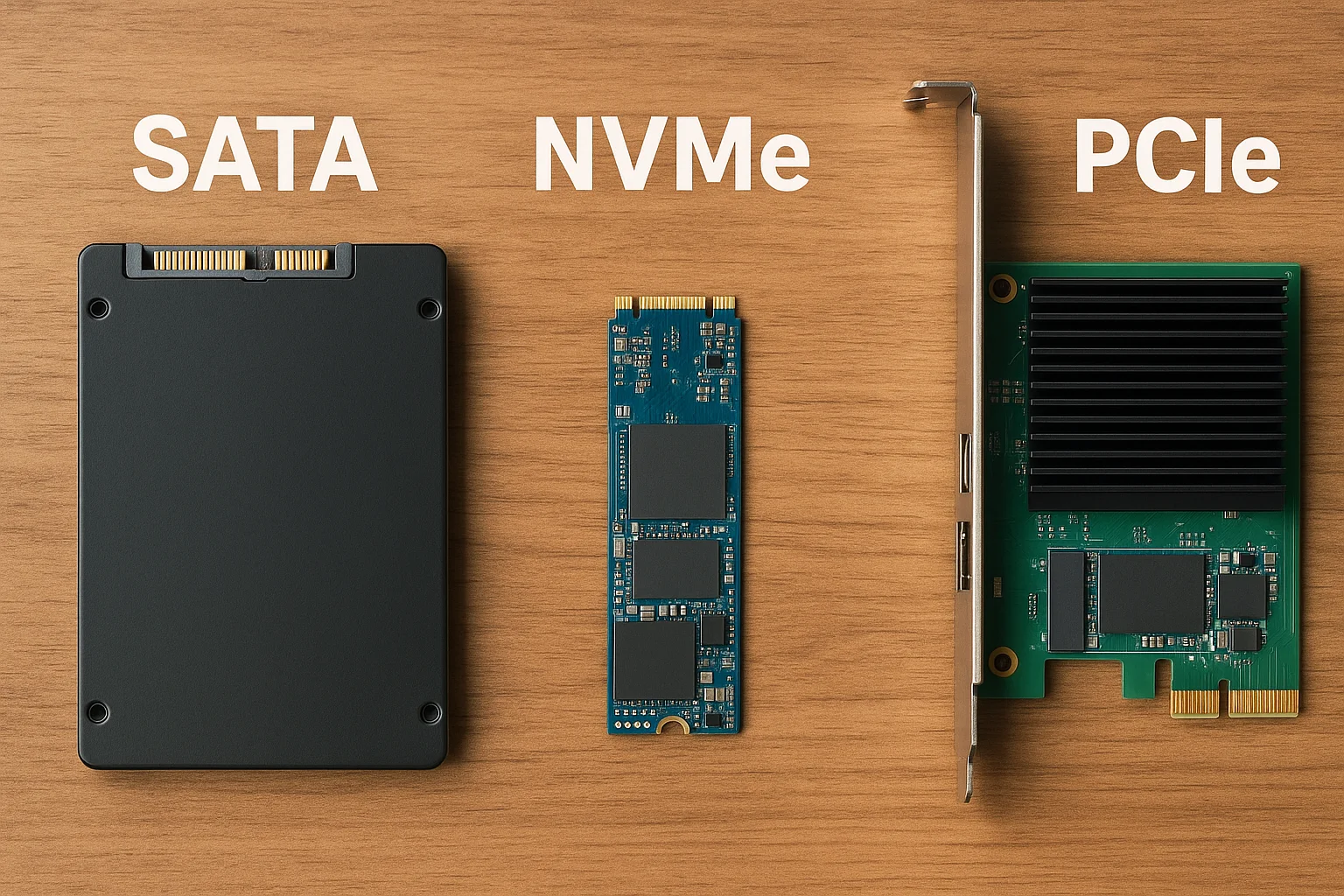Understanding How NVMe SSDs Work
NVMe, which stands for Non-Volatile Memory Express, is a storage protocol designed specifically to take full advantage of the speed potential of solid-state drives. Unlike older protocols such as SATA or AHCI, NVMe was built with flash memory in mind, reducing communication bottlenecks between the storage device and the CPU.
At the core of every NVMe SSD lies NAND flash memory, which stores data even when the power is turned off. This memory is organized into cells, and these cells are grouped into pages and blocks. Each write operation targets a page, while erasing data usually happens at the block level, which is why managing write cycles is so critical for performance and lifespan.
To control these operations, the SSD relies on a controller, often referred to as the brain of the drive. The controller manages where data is written, ensures wear-leveling across memory cells, and handles error correction. A good controller significantly influences the speed, reliability, and endurance of the SSD.
One of the main reasons NVMe outperforms older storage technologies is its ability to handle multiple input/output (I/O) queues simultaneously. Traditional interfaces were limited to a single command queue with a small number of commands, while NVMe supports thousands of parallel queues, each capable of managing thousands of commands at once. This parallelism reduces latency and enables NVMe SSDs to deliver the ultra-fast read and write speeds users expect.
Additionally, NVMe communicates directly with the CPU via the PCIe (Peripheral Component Interconnect Express) interface. This direct connection bypasses older bottlenecks and ensures data travels more quickly between storage and system resources, which is especially important for modern applications such as gaming, video editing, and data-intensive workloads.
Common Factors That Reduce SSD Lifespan
Although NVMe SSDs are built to deliver both speed and reliability, several conditions can gradually wear them down and shorten their useful life. Understanding these factors allows users to adopt better practices and avoid premature drive failures.
One of the primary concerns is the limited number of program/erase cycles that NAND flash memory can endure. Every time data is written and erased, the memory cells experience a small amount of degradation. Over time, repeated heavy write operations accumulate and reduce the overall endurance of the SSD.
Another significant factor is excessive heat. When SSDs operate at consistently high temperatures, the internal components, including the controller and memory cells, are stressed. This thermal strain can accelerate wear, lead to performance throttling, and in severe cases, cause data corruption. Maintaining proper cooling is therefore critical for longevity.
Filling an SSD to near full capacity also impacts its health. Operating without enough free space leaves less room for the controller to manage data efficiently through processes like wear leveling and garbage collection. As a result, write amplification increases, meaning the drive has to write more data than necessary, which in turn accelerates cell wear.
Another hidden issue is power instability. Sudden power losses, frequent hard shutdowns, or voltage fluctuations can interrupt write processes, potentially leading to data corruption and strain on the controller. Over time, unstable power conditions may reduce both reliability and lifespan.
Finally, certain user behaviors can also harm SSD durability. Practices such as running unnecessary disk benchmarks repeatedly, enabling outdated system utilities that constantly write to disk, or using the SSD as primary storage for heavy swap files and temporary caches all contribute to additional wear. Avoiding these habits helps preserve the health of the drive.
Keep Your Firmware and Drivers Updated
Maintaining up-to-date firmware and drivers for your NVMe SSD is one of the simplest yet most effective ways to ensure consistent performance and long-term reliability. Firmware acts as the internal operating system of the SSD, governing how the controller communicates with the memory cells and how tasks such as wear leveling or error correction are managed. Drivers, on the other hand, allow the operating system to interact efficiently with the hardware, ensuring that data transfers are executed smoothly.
SSD manufacturers frequently release firmware updates to address bugs, compatibility issues, and stability problems that may appear after the initial launch of a drive. In many cases, these updates also include optimizations that can improve performance or extend the endurance of the memory cells by refining how write operations are handled. Ignoring these updates means potentially missing out on fixes that could prevent data loss or unexpected failures.
Keeping drivers updated is equally important. While generic drivers provided by the operating system allow basic functionality, manufacturer-specific drivers are often optimized for advanced NVMe features. These can include better queue management, lower latency, or support for the latest power-saving technologies. Updated drivers also ensure compatibility with new system updates or hardware components, reducing the risk of instability or reduced performance.
Most SSD vendors provide dedicated software tools that make it easy to check for and install the latest firmware. These tools often include additional utilities such as health monitoring, temperature tracking, and diagnostic scans. Relying on such software not only simplifies updates but also helps users stay proactive about drive maintenance.
Before applying any firmware update, it is strongly recommended to back up important data. Although rare, update processes can occasionally fail due to power interruptions or system errors, which could compromise stored files. Taking this precaution ensures that your data remains safe while keeping your SSD up to date with the latest improvements.
Enable TRIM for Efficient Data Management
The TRIM command is an essential feature for SSDs, as it allows the operating system to inform the drive which blocks of data are no longer in use and can be safely erased. Unlike traditional hard drives, where overwriting data is straightforward, SSDs must first erase existing data in a block before writing new information. Without TRIM, the drive cannot distinguish between valid and invalid data, which leads to inefficiency and slower performance over time.
By enabling TRIM, the SSD can perform garbage collection more intelligently. This process clears unused blocks in the background, ensuring that future write operations are faster and more efficient. Without it, the drive has to spend additional time erasing data before writing, which results in increased latency and higher write amplification — both of which contribute to unnecessary wear on the memory cells.
On most modern operating systems, TRIM is enabled by default, but verifying this setting is a good practice. In Windows, for example, users can open a command prompt and run a simple query to confirm whether TRIM is active. On Linux, TRIM support can be enabled through mount options such as discard or by scheduling regular TRIM operations using the fstrim utility. macOS generally manages TRIM automatically on Apple-installed SSDs, but for third-party drives, manual activation may sometimes be required.
The benefits of TRIM extend beyond performance. Because it reduces unnecessary write operations, it also helps prolong the lifespan of the SSD. By ensuring that the drive writes only to clean blocks, TRIM minimizes wear on the flash memory, improving both endurance and reliability over the long term.
For users concerned about maximizing their SSD’s efficiency, enabling TRIM is a fundamental step. It not only maintains consistent speed but also reduces background workload on the controller, making the overall storage system more responsive and durable.
Monitor Temperature and Ensure Proper Cooling
Temperature is a critical factor in the overall health and performance of an NVMe SSD. These drives are capable of extremely high data transfer speeds, but such performance often generates significant heat. If the operating temperature rises above the recommended threshold, the SSD may activate thermal throttling, a protective mechanism that slows down performance to prevent hardware damage. While throttling protects the drive, it also reduces the responsiveness of the system.
Most manufacturers specify an optimal operating range for their SSDs, usually between 0°C and 70°C. Running the drive consistently near the upper limit can accelerate wear on the memory cells and controller, eventually shortening the drive’s lifespan. In extreme cases, prolonged overheating can even lead to data errors or complete failure of the device.
Monitoring temperature regularly helps to identify potential issues early. Many SSD vendors include management software capable of displaying real-time temperature readings, but third-party tools such as HWMonitor, CrystalDiskInfo, or Smartmontools can also be used to track thermal conditions. Setting alerts for abnormal heat levels ensures that corrective actions can be taken before damage occurs.
Ensuring proper cooling often involves both passive and active solutions. Passive methods include using heatsinks specifically designed for NVMe SSDs. These small metal plates attach directly to the drive, dissipating heat away from the controller and memory modules. Active cooling can be achieved through adequate case airflow, ensuring that fans are positioned to move hot air away from the SSD’s location on the motherboard.
In compact systems such as laptops or mini-PCs, heat management can be more challenging. In such cases, regularly cleaning dust from vents, elevating the device to improve airflow, or using external cooling pads can make a measurable difference in temperature regulation. For desktop users, placing the SSD away from other heat-producing components like GPUs also contributes to lower operating temperatures.
Consistently monitoring and maintaining proper cooling conditions not only preserves the stability and speed of the SSD but also reduces the likelihood of unexpected slowdowns caused by overheating.






